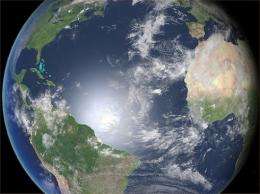July 22, 2011 report
Paleoecologists suggest mass extinction due to huge methane release

(PhysOrg.com) -- Micha Ruhl and colleagues from the University of Copenhagen's Nordic Center for Earth Evolution have published a paper in Science where they contend that the mass extinction that occurred at the end of the Triassic period, was due to a "sudden" increase in the amount of methane in the atmosphere due to the effects of global warning that resulted from the spewing of carbon dioxide from volcanoes.
Prior to this research, most scientists have believed that the sudden extinction of nearly half of all life forms on the planet was due solely to the emissions from volcanic eruptions that were occurring in what was to become the Atlantic Ocean. Ruhl et al contend that instead, what happened, was that the small amount of atmospheric heating that occurred due to the exhaust from the volcanoes, caused the oceans to warm as well, leading to the melting of ice crystals at the bottom of the sea that were holding on to methane created by the millions of years of decomposing sea life. When the ice crystals melted, methane was released, which in turn caused the planet to warm even more, which led to more methane release in a chain reaction, that Ruhl says, was the real reason for the mass extinction that led to the next phase in world history, the rise of dinosaurs.
Ruhl and his team base their assertions on studies they've made of the isotopes of carbon in plants (found in what is now the Austrian Alps) that existed during the period before the mass extinction. In so doing they found two different types of carbons and the molecules that were produced during that time frame. After extensive calculations, Ruhl and his team came to the conclusion that some 12,000 gigatons of methane would have had to have been pumped into the atmosphere to account for the differences in the isotopes; something the team believes could only have happened if the methane were to come from the sea floor.
This new research, though dire sounding, may or may not have implications for modern Earth. While it is true that humans have pumped significant amounts of carbon into the atmosphere, amounts that are approaching what Ruhl and his team say led to the earlier methane release, it doesn’t necessarily mean we are on the same path, because as Ruhl points out, things are much different today, the very structure of the planet has changed so much that it would be impossible to transfer what might have been learned about events in Earth’s history 200 million years ago, to what is going on today.
More information: Atmospheric Carbon Injection Linked to End-Triassic Mass Extinction, Science 22 July 2011: Vol. 333 no. 6041 pp. 430-434 DOI:10.1126/science.1204255
ABSTRACT
The end-Triassic mass extinction (~201.4 million years ago), marked by terrestrial ecosystem turnover and up to ~50% loss in marine biodiversity, has been attributed to intensified volcanic activity during the break-up of Pangaea. Here, we present compound-specific carbon-isotope data of long-chain n-alkanes derived from waxes of land plants, showing a ~8.5 per mil negative excursion, coincident with the extinction interval. These data indicate strong carbon-13 depletion of the end-Triassic atmosphere, within only 10,000 to 20,000 years. The magnitude and rate of this carbon-cycle disruption can be explained by the injection of at least ~12 × 103 gigatons of isotopically depleted carbon as methane into the atmosphere. Concurrent vegetation changes reflect strong warming and an enhanced hydrological cycle. Hence, end-Triassic events are robustly linked to methane-derived massive carbon release and associated climate change.
© 2010 PhysOrg.com















